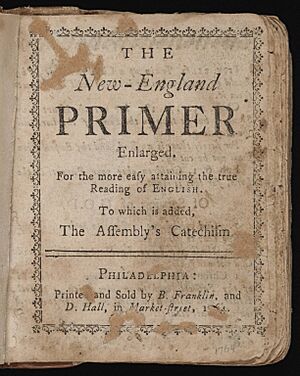Education in the Thirteen Colonies facts for kids
Education in the Thirteen Colonies was quite different depending on where you lived and your family's background. In the 17th and 18th centuries, only New England had public schools. People called Puritans thought reading was very important, especially for studying the Bible. This helped many more people in the colonies learn to read (about 70% of men) compared to Britain (40%) or France (29%).
Most children learned at home from their families. Boys usually had more chances to get an education than girls. In the Southern colonies, which were mostly farms, there were very few schools.

Contents
Learning in New England and the Middle Colonies
The Puritans in New England really believed in education. They wanted everyone to be able to read the Bible. They also wanted people to be able to take part in town meetings.
In 1647, Massachusetts passed a law. It said that every town with 50 or more families had to have an elementary school. Towns with 100 or more families needed a Latin or grammar school. These schools helped a few boys get ready for college to become ministers or lawyers. Most towns in New England tried to offer some schooling for their children. Both boys and girls went to elementary schools. They learned reading, writing, math, and religion.
The first Catholic school for both boys and girls opened in 1743. It was started by Father Theodore Schneider in Goshenhoppen, Pennsylvania. This school is still open today! In the middle colonies, private and religious schools were common. They offered similar learning as the public schools in New England.
Education in the Southern Colonies
The Southern colonies were mostly rural, meaning they had many farms and few towns. Because of this, there were not many schools until the time of the American Revolution.
Wealthy children often had private teachers called tutors. Children from middle-class families might learn to read from their parents or older brothers and sisters. Many poor white children and almost all Black children did not go to school at all. Because of this, fewer people in the South could read compared to the North. This difference lasted until the late 1800s.
One special school in the South was the Ursuline Academy in New Orleans. It was started in 1727 by Catholic sisters called the Ursulines. This school was the oldest school for girls that stayed open all the time. It was also the oldest Catholic school in the United States. The Ursuline Academy was the first place to have a female pharmacist. It also had the first classes for enslaved African-American women, free women of color, and Native Americans.
High Schools in Colonial Times
High schools were rare. You would only find them in big cities like Boston, New York City, Philadelphia, and Charleston. These schools mainly taught Latin grammar, public speaking, and advanced math. Their goal was to prepare boys for college. Some high schools also taught useful skills. These included accounting, navigation, surveying, and modern languages.
Some families sent their children to live and work with other families. This was often with relatives or close friends. It was a way for them to learn more skills and finish their education.
Colonial Colleges
The first colleges in the colonies were:
- Harvard University in Massachusetts (started 1636)
- The College of William & Mary in Virginia (started 1693)
- Yale University in Connecticut (started 1701)
- Princeton University in New Jersey (started 1746)
- Columbia University in New York (started 1754)
- University of Pennsylvania in Philadelphia (started 1755)
- Brown University in Rhode Island (started 1764)
- Rutgers University in New Jersey (started 1766)
- Dartmouth College in New Hampshire (started 1769)
Only white males were allowed to attend these colleges. Some students were as young as 14 or 15 years old. Most colleges had special classes to help students learn Latin or other basic skills if they needed them.
College teachers were usually few. There was often the college president (who was usually a religious leader), maybe one or two professors, and several tutors. Tutors were like graduate students who taught the younger students to pay for their own studies. All students followed the same course of study. This usually lasted three or four years. College studies focused on old languages, ancient history, religion, and math. In the 1700s, science (like astronomy and physics) and modern history and politics became a bit more important in the college lessons.
Until the mid-1700s, most American college graduates became Protestant clergymen (religious leaders). By the end of the colonial period, becoming a lawyer also became a popular career choice for college graduates.
Learning a Trade (Vocational Education)
Not many young people in the colonial era went to high school or college. However, many learned job skills through different types of vocational education. The most common way was through an apprenticeship.
Both boys and girls could become apprentices. This meant they lived and worked with a skilled person for a certain amount of time. This could be up to fifteen years for young orphans. Boys usually learned a trade, like being a blacksmith or a carpenter. Girls learned sewing and how to manage a household. Apprentices also learned reading and basic religious knowledge. Of course, many children learned job skills from their parents or employers without a formal apprenticeship.

